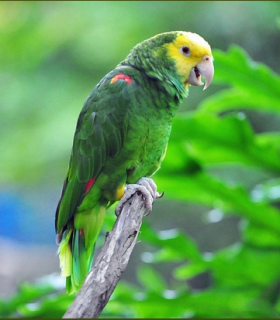Project Regions:
Yellow-headed Amazon |
|
|
Collaborators/Funders
Belize Zoo, Belize Bird Rescue, American Bird Conservancy (ABC), Kyle Brown Legacy, Barbara Delano Foundation
Central American parrot at risk of extinction
Yellow-headed Amazons are endangered in the wild due to trapping for the wild bird trade, persecution and extensive habitat loss.
Project and progress: In 1999 WPT and American Bird Conservancy (ABC) supported the Belize Zoo's educational programme to build awareness for Yellow-headed Amazons. WPT is currently collaborating with Belize Bird Rescue (BBR) to support the rehabilitation and rewilding of birds rescued from trade. BBR also engages local people in education and awareness programs profiling the threats to native parrots.
Outcomes: Belize Bird Rescue has released back to the wild over a hundred Yellow-headed Amazons as of 2019, more than 8% of the remaining wild population in Belize.
World population: Fewer than 7000
Where found: A.o. oratrix: Pacific slope of C Mexico, and Caribbean slope.
A.o. tresmariae: Islas Marias, off coast of W Mexico.
A.o. belizensis: C Belize and El Peten, N Guatemala; isolated populations NE Guatemala and NW Honduras.
A.o. hondurensis: Valle de Sula, NW Honduras.
A.o. magna: Tamaulipas, San Luis Potosí, Veracruz, Chiapas, Tabasco and Campeche.
History: The Yellow-headed Amazon (Amazona oratrix) has undergone a 90% population decline, since the mid-1970s, to 7,000 birds in 1994. There remains three subpopulations in Mexico: A. o. magna in Tamaulipas, San Luis Potosí, Veracruz, Chiapas, Tabasco and Campeche, A. o. oratrix from Jalisco to Oaxaca (Roberson and Carratello 1997) and A.o. tresmariae on the Islas Marías. Subspecies belizensis is now confined to central and northwest areas in Belize (Clay 1999).
Threats:
- Extensive habitat loss
- Heavy trapping for the wild bird trade
- Hunting for food
- Persecution as crop pest
- Loss of nest trees
Ecology: Yellow-headed Amazons are found in deciduous or evergreen forest, clearings, savanna woodland, Pinus woodlands on ridges, dense gallery woodland; less commonly in dry thorn forest, mangroves or coastal swamp forest and cultivated areas with scattered trees. They are reported to consume buds, new leaves, palm fruits, Acacia seeds, Macuna fruits, figs and some cultivated crops. They are found in pairs or flocks with larger gatherings at communal roosts and feed areas.


































